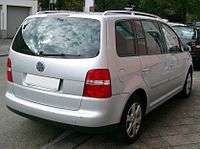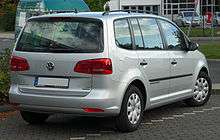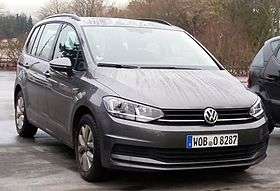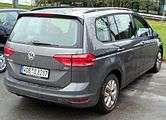Volkswagen Touran
| Volkswagen Touran | |
|---|---|
|
| |
| Overview | |
| Manufacturer |
Auto 5000 (2003–2008) Volkswagen (since 2009) |
| Also called | Volkswagen Golf Touran (J)[1][2] |
| Production | 2003–present |
| Assembly |
Wolfsburg, Germany Jakarta, Indonesia (Garuda Mataram Motor)[3] Anting, China (SVW) (2004-present) |
| Body and chassis | |
| Class | Compact MPV (M) |
| Body style | 5-door MPV |
| Layout | Front-engine, front-wheel drive |
| Platform | Volkswagen Group A5 (PQ35) platform |
| Related |
Audi A3 Mk2 VW Golf Mk5 Volkswagen Caddy Volkswagen Passat SEAT León Mk2 SEAT Altea SEAT Toledo Mk3 Škoda Octavia Mk2 |
| Powertrain | |
| Engine |
1.2L I4 TSI (from 2010) 1.4L I4 TSI (from 2007) 1.4L I4 TSI EcoFuel (from 2009) 1.6L I4 (until 2010) 1.6L I4 FSI (until 2006) 2.0L I4 FSI (until 2006) 2.0L I4 EcoFuel (from 2006 until 2009) 1.6L I4 TDI (from 2010) 1.9L I4 TDI (until 2010) 2.0L I4 TDI (from 2003) |
| Dimensions | |
| Wheelbase | 2,680 mm (105.5 in) |
| Length | 4,405 mm (173.4 in) |
| Width | 1,795 mm (70.7 in) |
| Height | 1,635 mm (64.4 in) |
The Volkswagen Touran (Typ 1T) is a compact MPV based on a vertically stretched fifth generation Volkswagen Golf Mk5, and sold in Europe and other select markets. It was launched in 2003 to fill a gap in Volkswagen's model lineup, below the Sharan large MPV. The vehicle is delivered in five- or seven-seat versions. It can be considered an extended version of the Golf Plus, since their front ends are similar in size, while the Touran's rear overhang is 200 mm (7.87 in) longer (and therefore a seven-seater, while the Golf Plus is a five-seater). In some regions, such as Japan, the car is called Golf Touran.
The name 'Touran' derives from the combination of 'Tour' and 'Sharan', the bigger MPV by VW. Despite the similarity of their names, the Touran is not related to the North American-market Volkswagen Routan.
First generation (2003–2007)

The Touran, launched in 2003, is the first Volkswagen MPV based on a Golf platform. It joined Volkswagen's existing MPV line-up that included the Sharan and Caravelle (VW Bus).[4]
The Touran introduced electro-mechanical steering, a first in its class and for Volkswagen. It is able to vary the weight of the steering depending on the road speed. Due to the lack of energy consumption in idle it also improves the overall efficiency of the vehicle. The Touran was the first vehicle to use Volkswagen's 2.0 TDI engine.
The engines available at the launch included a 1.6 FSI and two diesel engines, the 1.9 TDI with 74 kW (101 PS; 99 hp) and the 2.0 TDI 103 kW (140 PS; 138 hp). The engines are EURO 4 compliant, except the 1.9 TDi when paired with the DSG (direct shift gearbox). The Touran launched with a six-speed manual gearbox as standard and a DSG for the 1.9 TDI Engines.
Safety
The initial test of the Touran in 2003 resulted in a four-star rating for adult protection.[5] Volkswagen made slight changes to the Touran from November 2003, adding "an intelligent reminder for the driver and front passenger to buckle their seat belts." This allowed the Touran to be retested the same year, scoring a single extra point and so giving the car a five-star rating for adult protection:
Facelift (2006)
The Touran received a facelift for the October 2006 Paris Motor Show.
Park Assist
The 2007 model year Touran was the first production vehicle in the Volkswagen Group to be released with the new Park Assist technology. Park Assist helps the driver parallel park the vehicle. Firstly, after having activated the feature and whilst travelling up to 30 km/h Park Assist uses sensors to attempt to identify a suitable parking spot (defined as 0.8 metres longer than the length of the vehicle). The driver then stops ahead of the parking spot, releases the steering wheel, but continues working the gears, accelerator and brake pedal as advised by the display panels, as the Park Assist controls the steering to park the vehicle.
CrossTouran
At the December 2006 Bologna Motor Show, Volkswagen released the third Cross vehicle designed by Volkswagen Individual GmbH.
The CrossTouran is distinguished from a standard Touran by its 17-inch alloy wheels, redesigned plastic guards which ape a crossover vehicle, and a 15 mm (0.59 in) higher suspension/chassis setup that is optional for standard Tourans in Europe.
All CrossTouran engines are EU4 compliant.
- 1.6 with 75 kW / 102 hp
- 1.4 TSI with 103 kW / 140 hp
- 2.0 TSI with 125 kW / 170 hp
- 1.9 TDI with 77 kW / 105 hp
- 2.0 TDI with 103 kW / 140 hp
- 2.0 TDI with 125 kW / 170 hp
Second facelift (2010–2015)


In August 2010 the Touran was updated to the newer Golf VI platform (PQ35). This included as new features compared to the previous facelift the option for DCC (Volkswagen's adaptive suspension system), Light-Assist for Xenon Headlights, an improved Park-Assist System that can also handle perpendicular park positions and updated infotainment systems. The aerodynamics of the car were also improved, the Cw improved from 0,31-0,32 to 0,29.
At the end of 2010 Shanghai Volkswagen Automotive released the new Touran in China.[7] Though its front was updated to the German style, the tail keeps the design of the phase II model. The electronic systems of this domestically produced car were upgraded as its relative in Europe. A 1.4 TSI which can output 93 kW was added to the new model.
New engines were available following the downsizing trend, a 1.2 with 77 kW (105 PS; 103 hp) and a new 1.6 Common Rail TDI with 66 kW (90 PS; 89 hp) or 77 kW (105 PS; 103 hp).[8] They replaced the 1.6 and 1.9 TDI from the previous model. The 1.2, 77 kW (105 PS; 103 hp) and 1.6 TDI 77 kW (105 PS; 103 hp) were also available as BlueMotion, Volkswagen's low fuel consumption vehicle program.
In 2012, the 125 kW (170 PS; 168 hp) engine was replaced with the 130 kW (177 PS; 174 hp).
Engines
The Touran is available with petrol, diesel and compressed natural gas (CNG) engines.
| Model | Years | Engine and code | Displ. | Power | Torque | |
|---|---|---|---|---|---|---|
| 1.2 TSI | 2010–2015 | I4 8V | CBZB | 1,197 cc | 77 kW (105 PS; 103 hp) @ 5,000 rpm | 175 N·m (129 lb·ft) @ 1,550-4,100 rpm |
| 1.4 TSI | 2006–2010 | I4 16V | BMY/CAVC | 1,390 cc | 103 kW (140 PS; 138 hp) @ 5,600 rpm | 220 N·m (160 lb·ft) @ 1,250–4,000 rpm |
| 1.4 TSI | 2007–2015 | I4 16V | BLG/CAVB | 1,390 cc | 125 kW (170 PS; 168 hp) @ 6,000 rpm | 240 N·m (180 lb·ft) @ 1,500 rpm–4,500 rpm |
| 1.4 TSI EcoFuel | 2009–2015 | I4 16V | CDGA | 1390 cc | 110 kW (150 PS; 148 hp) @ 5,500 rpm | 220 N·m (160 lb·ft) @ 1,500–4,500 rpm |
| 1.6 | 2003–2010 | I4 8V | BGU/BSE/BSF | 1,595 cc | 75 kW (102 PS; 101 hp) @ 5,600 rpm | 148 N·m (109 lb·ft) @ 3,800 rpm |
| 1.6 FSI | 2003–2006 | I4 16V | BAG/BLF/BLP | 1,598 cc | 85 kW (116 PS; 114 hp) @ 6,000 rpm | 155 N·m (114 lb·ft) @ 4,000 rpm |
| 2.0 FSI | 2003–2006 | I4 16V | AXW/BLR/BLX/BVY | 1,984 cc | 110 kW (150 PS; 148 hp) @ 6,000 rpm | 200 N·m (150 lb·ft) @ 3500 rpm |
| 2.0 EcoFuel | 2006–2009 | I4 8V | BSX | 1,984 cc | 80 kW (109 PS; 107 hp) @ 5,400 rpm | 160 N·m (120 lb·ft) @ 3,500 rpm |
| 1.6 TDI | 2010–2015 | I4 16V | CAYB | 1,598 cc | 66 kW (90 PS; 89 hp) @ 4,200 rpm | 230 N·m (170 lb·ft) @ 1,500–2,500 rpm, |
| 1.6 TDI | 2010–2015 | I4 16V | CAYC | 1,598 cc | 77 kW (105 PS; 103 hp) @ 4,400 rpm | 250 N·m (180 lb·ft) @ 1,500–2,500 rpm, |
| 1.9 TDI | 2004–2010 | I4 8V | BRU/BXF/BXJ | 1,896 cc | 66 kW (90 PS; 89 hp) @ 4,000 rpm | 210 N·m (150 lb·ft) @ 1,800–2,500 rpm |
| 1.9 TDI | 2003–2004 | I4 8V | AVQ | 1,896 cc | 74 kW (101 PS; 99 hp) @ 4,000 rpm | 250 N·m (180 lb·ft) @ 1,900 rpm |
| 1.9 TDI | 2004–2010 | I4 8V | BJB/BKC/BXE/BLS | 1,896 cc | 77 kW (105 PS; 103 hp) @ 4,000 rpm | 250 N·m (180 lb·ft) @ 1,900 rpm |
| 2.0 TDI | 2003–2004 | I4 16V | AZV | 1,968 cc | 100 kW (136 PS; 134 hp) @ 4,000 rpm | 320 N·m (240 lb·ft) @ 1,750–2,500 rpm |
| 2.0 TDI | 2004–2010 | I4 16V | BKD | 1,968 cc | 103 kW (140 PS; 138 hp) @ 4,000 rpm | 320 N·m (240 lb·ft) @ 1,750–2,500 rpm |
| 2.0 TDI DPF | 2005–2010 | I4 8V | BMM | 1,968 cc | 103 kW (140 PS; 138 hp) @ 4,000 rpm | 320 N·m (240 lb·ft) @ 1,750–2,500 rpm |
| 2.0 TDI DPF | 2010–2015 | I4 16V | CBAB | 1,968 cc | 103 kW (140 PS; 138 hp) @ 4,200 rpm | 320 N·m (240 lb·ft) @ 1,750–2,500 rpm |
| 2.0 TDI DPF | 2005–2010 | I4 16V | BMN | 1,968 cc | 125 kW (170 PS; 168 hp) @ 4,200 rpm | 350 N·m (260 lb·ft) @ 1,750–2,500 rpm |
| 2.0 TDI DPF | 2012–2015 | I4 16V | CFJB | 1,968 cc | 130 kW (177 PS; 174 hp) @ 4,200 rpm | 380 N·m (280 lb·ft) @ 1,750–2,500 rpm |
The diesel models of the Touran offer better fuel economy. Given the proper conditions, it is possible to achieve over 60 mpg-imp (4.7 L/100 km; 50 mpg-US) in a diesel Touran.[9] The car is delivered with a five- (1.6 only) and six-speed manual transmissions, Tiptronic six-speed automatic transmission (in 1.6, 1.6 FSI and 2.0 FSI (2003-2006 only)) or the DSG twin-clutch automatic transmission; the 1.4 TSI, the 1.6 FSI from 2003 to 2006, the 1.9 TDI from 2003 to 2008 and the 2.0 TDI uses the six-speed version, and the 1.9 TDI since the middle of 2008 use the seven-speed dry-clutch version.
As for the 2010 model, an updated version of the 2.0 TDI engine was launched with common rail technology. The engine was introduced in the Volkswagen Passat in the 2008-models.
Touran Hy Motion and Hybrid
The Touran Hy Motion is Volkswagen's Hydrogen Development concept. It has a nickel-metal hydride battery which produces 80 kW (107 hp), it does the 0–100 km/h (0-62 mph) sprint in 14 seconds and has a top speed of 140 km/h (87.0 mph).
In 2008, Shanghai-Volkswagen with Tongji University had released a Touran Hybrid as part of the lead up to the 2008 Beijing Olympic Games.
A prototype of the Touran Hybrid was shown with a 20 kW (27 hp) electric motor in conjunction with a 110 kW (148 hp) petrol engine, the transmission will most likely be Volkswagen's Direct-Shift Gearbox (DSG).
Awards
- The Touran won What Car?'s 2005 Compact Van of the Year award.
- The Touran scored a maximum 5-star EuroNCAP crash safety rating.
Second generation (2015–)
| Volkswagen Touran II | |
|---|---|
 | |
| Overview | |
| Production | 2015 – |
| Assembly | Wolfsburg, Germany |
| Body and chassis | |
| Class | Compact MPV (M) |
| Body style | 5-door MPV |
| Layout | Front-engine, front-wheel drive |
| Platform | Volkswagen Group MQB platform |
| Powertrain | |
| Engine |
1.2L I4 TSI 1.4L I4 TSI 1.6L I4 TDI 2.0L I4 TDI |
| Dimensions | |
| Wheelbase | 2,791 mm (109.9 in) |
| Length | 4,527 mm (178.2 in) |
| Width | 1,829 mm (72.0 in) |
| Height | 1,628 mm (64.1 in) |
The second generation Touran was introduced at the 2015 Geneva Motor Show. It uses the Volkswagen Group MQB platform and offers increased cabin space, four new engines with 19 percent less fuel consumption, and an array of new advanced driver assistance systems and infotainment options.[10] Autoradio with android auto is included.
Engine Specifications
| Model | Year(s) | Displacement | Fuel Type | Power | Torque | 0–100 km/h (0–62 mph) | CO2 Emissions |
|---|---|---|---|---|---|---|---|
| 1.2 TSI BMT | 05/2015– | 1,197 cc (73.0 cu in) | Petrol | 110 PS (81 kW; 108 bhp) | 175 N·m (129 ft·lbf) | 11.3 s | 128 g/km |
| 1.4 TSI BMT DSG | 05/2015– | 1,395 cc (85.1 cu in) | Petrol | 150 PS (110 kW; 148 bhp) | 250 N·m (184 ft·lbf) | 8.9 s | 126 g/km |
| 1.8 TSI BMT DSG | 02/2016– | 1,798 cc (109.7 cu in) | Petrol | 180 PS (132 kW; 178 bhp) | 250 N·m (184 ft·lbf) | 8.3 s | 140 g/km |
| Model | Year(s) | Displacement | Fuel Type | Power | Torque | 0–100 km/h (0–62 mph) | CO2 Emissions |
|---|---|---|---|---|---|---|---|
| 1.6 TDI BMT | 05/2015– | 1,598 cc (97.5 cu in) | Diesel | 110 PS (81 kW; 108 bhp) | 250 N·m (184 ft·lbf) | 11.9 s | 116 g/km |
| 2.0 TDI BMT | 05/2015– | 1,968 cc (120.1 cu in) | Diesel | 150 PS (110 kW; 148 bhp) | 340 N·m (251 ft·lbf) | 9.3 s | 116 g/km |
| 2.0 TDI BMT | 02/2016– | 1,968 cc (120.1 cu in) | Diesel | 190 PS (140 kW; 187 bhp) | 400 N·m (295 ft·lbf) | 8.2 s | 123 g/km |
Gallery Touran II
-

VW Touran II front
-

Rear view
References
- ↑ "Volkswagen Interactive". Volkswagen.co.jp. Retrieved 2011-06-25.
- ↑ "ゴルフトゥーラン(フォルクスワーゲン GOLF_TOURAN)のカタログ | 中古車ならGoo-net(グーネット)" (in Japanese). Goo-net.com. Retrieved 2011-06-25.
- ↑ "Indonesia: Volkswagen To Launch Local Assembly, Likely of Touran and Golf Plus". Insideline.com. 2009-05-12. Retrieved 2010-11-01.
- ↑ "Volkswagen Touran". Fleet News. 2003-08-07. Retrieved 2013-05-14.
- ↑ "Euro NCAP 2003". Retrieved 2011-10-23.
- ↑ "Euro NCAP 2003 retest". Retrieved 2011-10-23.
- ↑ "Touran China official site".
- ↑ "Entdecken Sie den Touran in 8 Ausstattungsvarianten.". Touran < Modelle (in German). Volkswagen Deutschland/Volkswagen.de. Retrieved 2010-12-14.
- ↑ "Volkswagen Touran". Auto Express. November 2010. Retrieved 2011-11-09.
- ↑ "Volkswagen presents the new Touran". Volkswagen Media Services. Volkswagen AG. 2015-02-24. Retrieved 2015-02-25.
- ↑ "Volkswagen Touran 3 - Technical specifications, size dimensions, fuel economy". ultimatespecs.com.
- ↑ "Volkswagen Touran 3 - Technical specifications, size dimensions, fuel economy". ultimatespecs.com.
External links
| Wikimedia Commons has media related to Volkswagen Touran. |
| ||||||||||||||||||||||||||||||||||||||||||||||||||||||||||
| « previous — Volkswagen Passenger Cars, a marque of the Volkswagen Group, car timeline, European market, 1980s–present | |||||||||||||||||||||||||||||||||||||
|---|---|---|---|---|---|---|---|---|---|---|---|---|---|---|---|---|---|---|---|---|---|---|---|---|---|---|---|---|---|---|---|---|---|---|---|---|---|
| Type | 1980s | 1990s | 2000s | 2010s | |||||||||||||||||||||||||||||||||
| 0 | 1 | 2 | 3 | 4 | 5 | 6 | 7 | 8 | 9 | 0 | 1 | 2 | 3 | 4 | 5 | 6 | 7 | 8 | 9 | 0 | 1 | 2 | 3 | 4 | 5 | 6 | 7 | 8 | 9 | 0 | 1 | 2 | 3 | 4 | 5 | 6 | |
| Economy car | Beetle | ||||||||||||||||||||||||||||||||||||
| City car | Lupo | Fox | up! | ||||||||||||||||||||||||||||||||||
| Supermini | Polo / Derby I | Polo / Derby II | Polo III | Polo IV | Polo V | ||||||||||||||||||||||||||||||||
| Small family car | Golf I | Golf II | Golf III | Golf IV | Golf V | Golf VI | Golf VII | ||||||||||||||||||||||||||||||
| Jetta I | Jetta II | Vento | Bora | Jetta V | Jetta VI | ||||||||||||||||||||||||||||||||
| New Beetle | Beetle | ||||||||||||||||||||||||||||||||||||
| Large family car | Passat I | Passat II / Santana | Passat III | Passat IV | Passat V | Passat VI | Passat VII | Passat VIII | |||||||||||||||||||||||||||||
| Passat CC | CC | ||||||||||||||||||||||||||||||||||||
| Luxury car | Phaeton | ||||||||||||||||||||||||||||||||||||
| Coupé | Scirocco I | Scirocco II | Scirocco III | ||||||||||||||||||||||||||||||||||
| Corrado | |||||||||||||||||||||||||||||||||||||
| Convertible | Golf I Cabriolet | Golf III Cabriolet | Golf VI Cabriolet | ||||||||||||||||||||||||||||||||||
| New Beetle Cabriolet | Beetle Cabriolet | ||||||||||||||||||||||||||||||||||||
| Eos | |||||||||||||||||||||||||||||||||||||
| Compact MPV | Golf Plus | Golf Sportsvan | |||||||||||||||||||||||||||||||||||
| Touran I | Touran II | ||||||||||||||||||||||||||||||||||||
| Large MPV | Sharan I | Sharan II | |||||||||||||||||||||||||||||||||||
| SUV | Tiguan I | Tiguan II | |||||||||||||||||||||||||||||||||||
| Touareg I | Touareg II | ||||||||||||||||||||||||||||||||||||
| |||||||||||||||||||||||||||||||||||||